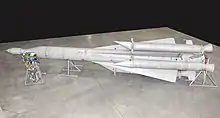
Kholod (Холод) is an experimental Russian rocket project. The hypersonic rocket uses a scramjet engine and was created to exceed Mach 6+ The prototype consists of a Soyuz TMKB with liquid hydrogen and modified fillings from the SA-5 Gammon missiles. The entire rocket, including the four booster rockets, is 12 metres (39 ft) long and 750 millimetres (30 in) in diameter.[1][2][3][4][5][6][7] The project led to other Russian hypersonic rockets like the Igla rocket craft and the Yu-71 boost-glide warhead.
The Kholod became part of a joint CIAM/NASA project to enhance the fundamental understanding of variable geometry ram/scramjet hybrids beginning in the 1990s.[8] These tests resulted in successful flights from Sary Shagan test range in central Kazakhstan in 1998.
The aim of the partnership was to test the Kholod's scramjet at Mach 6.5 while recording all relevant test data both onboard and via telemetry. The Kholod allowed for the testing of variable hypersonic flow, ramjet/scramjet geometry, and more importantly to act as a litmus test to ensure that the data produced by ground experiments was consistent with real world testing at altitude.
The Kholod contained an array of 83 pressure transducers and 58 thermocouples, to monitor the effects of hypersonic flow on the leading edge and inlet. The Kholod's sustained run of its dual mode ramjet/scramjet was primarily enabled by the development of a new alloy named "FeCrAl". The new alloy consisted of steel (Fe), chromium (Cr), and aluminum (Al) that was then covered with chromium-nickel spray; this was a major improvement over the use of the stainless steel alloy EP-666.
The information obtained by the Hypersonic Flying Laboratory enabled researchers to begin designing the next generation of ramjets and scramjets.[9]
Russia would continue to research scramjet platforms under the ORYOL-2-1 program that focused on developing the GLL-8 Igla platform. The success of the Kholod program led to the development of NASA's X-43 to further refine the mechanics of scramjets and to develop control surfaces to enable maneuverability at hypersonic speeds.[10]
References
- ↑ "Kholod project". www.russianspaceweb.com.
- ↑ Roudakov, A.S., Y. Schickhman, V. Semenov, Ph. Novelli, and O. Fourt, "Flight Testing an Axisymmetric Scramjet: Russian Recent Advances," 44th Congress of the International Astronautical Federation, Oct. 16– 22, 1993, Graz, Austria
- ↑ "Prototypes.com/La saga des statoréacteurs/XVII. Les records de vitesse". xplanes.free.fr.
- ↑ "Supersonic HFL Kholod Mach 6.47 scramjet to go up for auction". Zee News. July 23, 2014.
- ↑ Gorey, Colm (July 22, 2014). "Supersonic scramjet to go up for auction in London". Silicon Republic.
- ↑ Sheikh, Shahzad (July 21, 2014). "Used rocket for sale, two careless owners".
- ↑ "'Cool' Russian rocket installed in Wiltshire garden". BBC News. BBC. Retrieved 26 May 2015.
- ↑ Roudakov, Alexander S., Semenov, Vyacheslav L., Hicks, John W. "Recent Flight Test Results of the Joint CIAM-NASA Mach 6.5 Scramjet Flight Program." NASA Technical Reports Server, August 8, 2018. Accessed March 3, 2021. https://ntrs.nasa.gov/citations/19980137604.
- ↑ Roudakov, Alexander S., Semenov, Vyacheslav L., Hicks, John W. "Recent Flight Test Results of the Joint CIAM-NASA Mach 6.5 Scramjet Flight Program." NASA Technical Reports Server, August 8, 2018. Accessed March 3, 2021. https://ntrs.nasa.gov/citations/19980137604.
- ↑ Alexander Roudakov, Vyacheslav Semenov, Valeriy Kopchenov and John Hicks. "Future flight test plans of an axisymmetric hydrogen-fueled scramjet engine on the Hypersonic Flying Laboratory," AIAA 1996-4572. Space Plane and Hypersonic Systems and Technology Conference. November 1996. Accessed March 3, 2021. https://arc.aiaa.org/doi/10.2514/6.1996-4572.
.svg.png.webp)